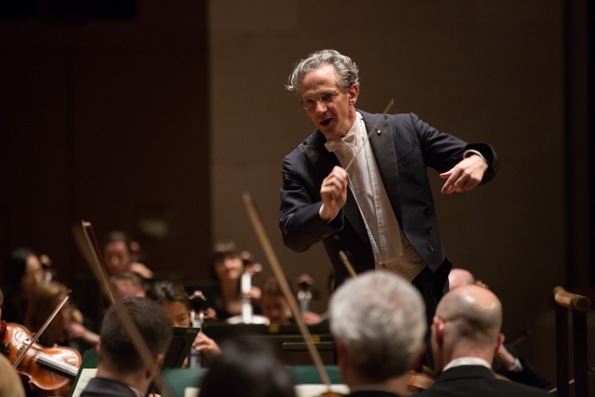Dallas Symphony musicians take the spotlight in music of Strauss and Berlioz

Under the baton of music director Fabio Luisi, the Dallas Symphony Orchestra tackled two rarities and a beloved Romantic warhorse Saturday night.
First, the rarities. Gottfried von Einem’s Capriccio for orchestra opened the program. Einem was an Austrian composer whose early work was disrupted by World War II. He was posthumously acclaimed for helping to save the life of a Jewish musician, Konrad Latte.
The composer’s heroism notwithstanding, the Capriccio is worth multiple listens. Its sparkling counterpoint and jazz influences (was that a near-quote from American in Paris near the end?) create a fun, fast moving nine minutes of music that is a showpiece for any orchestra. The DSO mostly delivered in this difficult piece, with tight ensemble within string sections. Between sections is another matter; the orchestra has been rearranged in the past few weeks, with firsts and seconds facing each other in the Classical-era antiphonal arrangement. The strings seem to be struggling a bit with the layout—ensemble between firsts and seconds isn’t yet dialed in, and basses, at the back left of the stage, seem to be in another Zip code visually and acoustically.
The other relative rarity was Richard Strauss’s Duett-Concertino (for clarinet, bassoon, string orchestra and harp). The piece is a quasi-tone poem based on some inscrutable variation of Beauty and the Beast. (Strauss offered contradictory explanations).
The first movement opens gorgeously, scored for string quartet and clarinet. Yet, largely because of the orchestra’s new arrangement, the second violin and viola were swallowed up, while Alex Kerr’s first violin and Chris Adkins’ cello dominated. Still, it was a lovely effect to establish the “princess” theme. Principal clarinet Greg Raden delighted with a deliciously rich sound, and principal bassoon Ted Soluri offered a warm, dusky tone. Clarinet and orchestra tended to ride on top opf the balances yet the playing throughout was marvelous in this rare opportunity for front-desk players.
The showpiece of the program was Berlioz’s Symphonie fantastique. After two pandemic years of reduced orchestra sizes, seeing four harps set up on stage was a thrill. Symphonie fantastique is program music designed, in essence, to express Berlioz’s distress at his then-unrequited love for actress Harriet Smithson. (Smithson and Berlioz did eventually marry, resulting in spectacular unhappiness for both.)
This was a monumental and memorable performance overall, with only a few minor glitches detracting. Despite the aforementioned balance problems in the strings, the overall effects of the first and second movements, Rêveries and Un bal, were most delightful. The orchestra performed the second movement without the solo cornet part that Berlioz included in the autograph score; it is a frequent yet regrettable omission. Luisi ably shaped the orchestra to emphasize the ideé fixe theme, which represents The Beloved, aka Harriet Smithson.
The absolute showstopping moment, though, occurred at the beginning of the third movement (Scène aux champs), in which the English horn (David Matthews) and an offstage oboe (associate principal Willa Henigman) trade a melancholy tune, which is then picked up in flute and violins. Matthews and Henigman were stunningly good Saturday night, making this simple tune even more delicious than the thrilling bombast that follows.
The fourth movement, March au supplice, depicting the artist’s despairing opium dream, includes a singularly tricky, exposed bassoon solo played with finesse by associate principal Scott Walzel. But it’s the final movement, the Witches’ Sabbath, or Song d’une nuit du sabbat, that fills seats in performance after performance.
Luisi’s conducting was masterful and Saturday’s performance included one spectacular moment after another. Among them were Stephanie Key’s well-crafted E-flat clarinet solo and principal percussionist George Nickson’s tolling of the bells (commissioned by the DSO in 1984 especially for the Berlioz work). The low brass thundering the Dies irae and the special effects in the strings, playing with the wood of the bow nearly on the bridge, add to the spooky effect